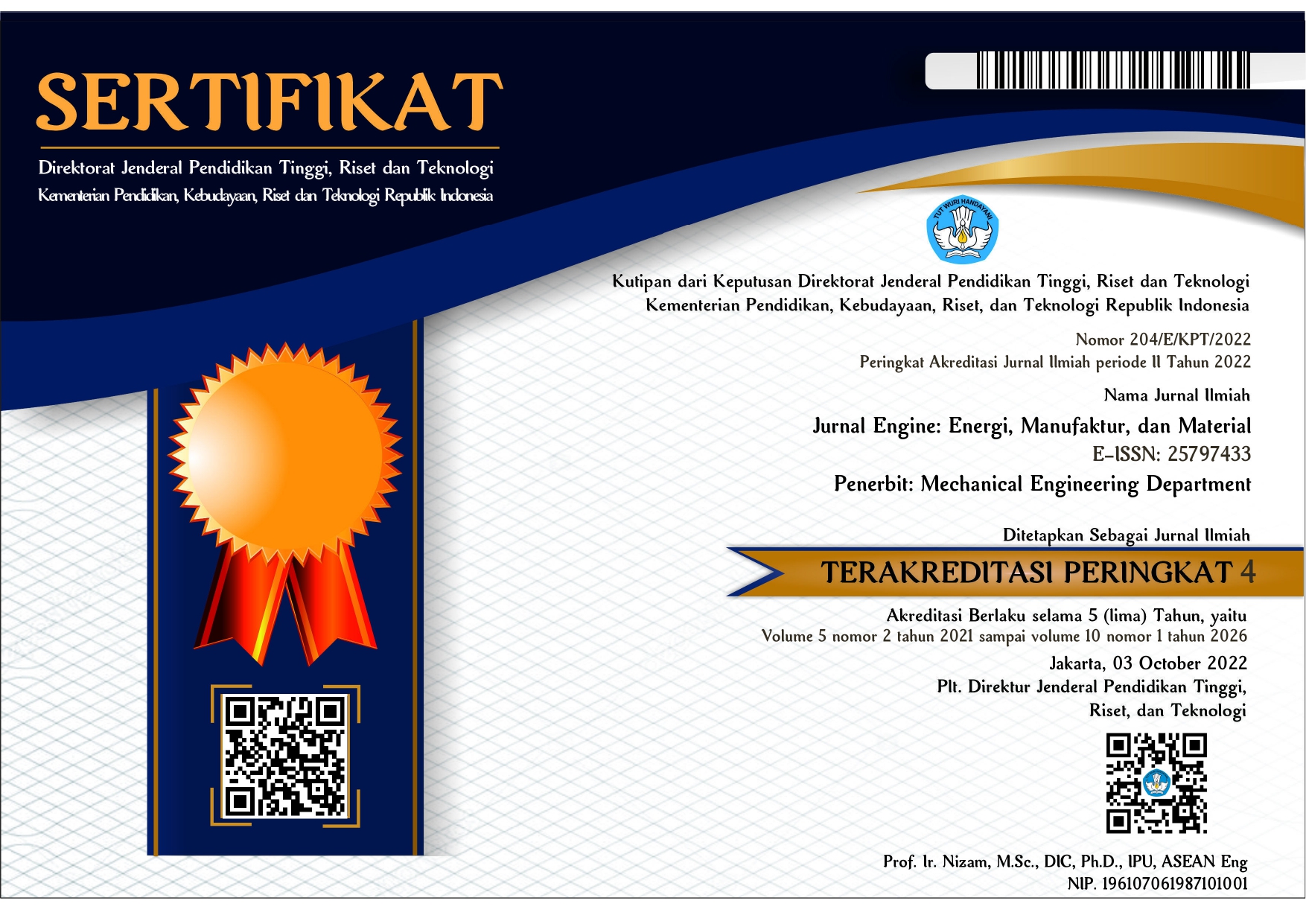Analisis Sistem Pemantauan Pemisah Sampah Logam dan Non Logam berbasis Internet of Things
DOI:
https://doi.org/10.30588/jeemm.v7i1.1462Keywords:
Internet of Things, IoT, Sensor, WasteAbstract
Waste has become a serious problem, especially in big cities, not only in Indonesia but also around the world. Waste production continues to increase along with population growth, and changes in consumption patterns and people's lifestyles have increased the amount of waste, the type, and the diversity of waste characteristics. Waste bins are infrastructure available in every city park that makes it easier for park visitors to dispose of waste. make it easier for park visitors to dispose of waste. In some places, There are no bins based on the basic material of the waste, namely metal bins and non-metal bins that can be monitored in real-time. So a smart trash can is made that can sort metal or non-metal waste that can be monitored in real-time with the Internet of Things. The hardware used is Metal Proximity Sensor, Infrared Sensor, Servo Motor, Ultrasonic Sensor, MQ135 Gas Sensor, and ESP32 Microcontroller. The capacity in the trash can be monitored through the Blynk application, which will provide notification when the trash can is full. Based on the test results of the volume reading of the trash can, the success of the sensor to open and close is 99.26%. To sort non-metal waste and metal waste using proximity sensors with the results of testing the reading of waste objects obtained success in non-metal waste by 95% and metal waste by 100%.
References
Ariessanti, H. D., Martono, & Widiarto, J. (2019). Sistem Pembuangan Sampah Otomatis Berbasis IOT Menggunakan Mikrokontroler pada SMAN 14 Kab.Tangerang. 12(2), 229–240.
Ayutantri, D. A., Dedy Irawan, J., & Wibowo, S. A. (2021). PENERAPAN IoT (Internet of Things) DALAM PEMBUATAN TEMPAT SAMPAH PINTAR UNTUK RUMAH KOS. JATI (Jurnal Mahasiswa Teknik Informatika), 5(1), 115–124. https://doi.org/10.36040/jati.v5i1.3263
Azmi, Z., Ramadhan, M., & Supriyadi. (2017). Tong sampah cerdas via sms. 16(2), 142–150. www.SensorUltrasonik.co.id
Dermawan, H., Ardilah, N. A., & Sidauruk, D. (2021). SISTEM MONITORING SAMPAH DI SELURUH TPS KABUPATEN BREBES.
Fadel, F. (2017). The Design and Implementation of Smart Trash Bin. Academic Journal of Nawroz University, 6(3), 141–148. https://doi.org/10.25007/ajnu.v6n3a103
Kaur, A., & Jasuja, A. (2017). Cost Effective Remote Health Monitoring System Based on IoT Using Arduino UNO. Advances in Computer Science and Information Technology (ACSIT), 4(2), 80–84.
Malik, M., & Prasetyo, A. (2022). Design a Smart Trash Using Fuzzy Logic Algorithm. ICSET: International Conference on …, 9–17. https://seminar.ustjogja.ac.id/index.php/ICSET/article/view/199%0Ahttps://seminar.ustjogja.ac.id/index.php/ICSET/article/download/199/123
Putrawan, E., Made, G., Desnanjaya, N., Nyoman, I., Hartawan, B., Komputeri, S., & Stikom Indonesia, S. (2021). Implementasi Alat Pengontrol Pengumpul Sampah pada Irigasi Aliran Air Sawah Menggunakan Mikrokontroler. Jurnal Krisnadana, 1(1), 57–68. https://ejournal.catuspata.com/index.php/jkdn/index
Sanjaya I.P, A., & Hendriyawan A, M. . (2017). Rancang Bangun Sistem Pemantauan Dan Manajemen Sampah Di Kawasan Perkotaan Menggunakan Internet Of Things. Universitas Teknologi Yogyakarta.
Saputra, M. A., Wirawan, I. G. P. W. W., & Zubaidi, A. (2021). Rancang Bangun Smart Trash Can Berbasis IOT (Internet Of Things) Untuk Petugas Sampah Perumahan. Jurnal Teknologi Informasi, Komputer, Dan Aplikasinya (JTIKA ), 3(1), 120–132. https://doi.org/10.29303/jtika.v3i1.134
Suhaeb, S., Abd Djawad, Y., Jaya, H., Ridwansyah, Sabran, & Risal, A. (2017). Mikrokontroler dan Interface. In Buku Ajar Jurusan Pendidikan Teknik Elektronika UNM. https://scholar.google.co.id/scholar?hl=id&as_sdt=0%2C5&q=jurnal+artikel+ilmiah&btnG=
Sulistiorini, I. N. (2022). Pengelolaan Sampah Rumah Tangga. Dinas Lingkungan Hidup Dan Kehutanan Daerah Istimewa Yogyakarta. https://dlhk.jogjaprov.go.id/pengelolaan-sampah-rumah-tangga
Wicaksono, H. A. (2017). Rancang Bangun Sistem Monitoring Kosentrasi Gas Nitrogen Oksida (NOX) Sebagai Emisi Gas Buang Menggunakan Sensor Gas MQ-135 Berbasis Mikrokontroler TM32F4 Discovery.
Downloads
Additional Files
Published
How to Cite
Issue
Section
License
Authors who publish with Jurnal Engine: Energi, Manufaktur, dan Material agree to the following terms:
Authors retain copyright and grant the Jurnal Engine: Energi, Manufaktur, dan Material right of first publication with the work simultaneously licensed under a Creative Commons Attribution 4.0 International License that allows others to share (copy and redistribute the material in any medium or format) and adapt (remix, transform, and build upon the material) the work for any purpose, even commercially with an acknowledgment of the work's authorship and initial publication in Jurnal Engine: Energi, Manufaktur, dan Material. Authors are able to enter into separate, additional contractual arrangements for the non-exclusive distribution of the journal's published version of the work (e.g., post it to an institutional repository or publish it in a book), with an acknowledgment of its initial publication in Jurnal Engine: Energi, Manufaktur, dan Material. Authors are permitted and encouraged to post their work online (e.g., in institutional repositories or on their website) prior to and during the submission process, as it can lead to productive exchanges, as well as earlier and greater citation of published work (See The Effect of Open Access).

















